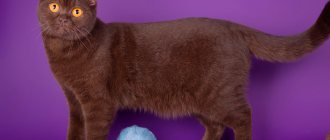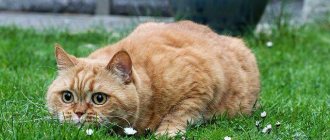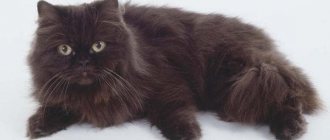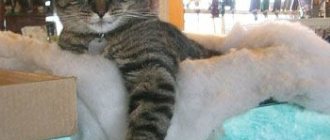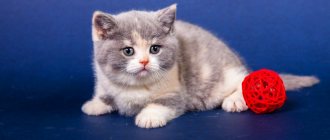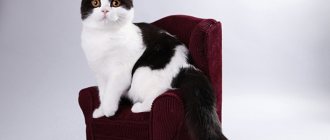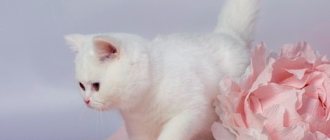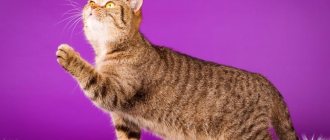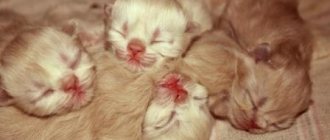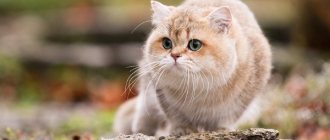The Somali cat is an amazingly beautiful creature. In 1967, Evilyn Megue, an American breeder of Abyssinian cats, took into her home a cat that had already been abandoned by about five owners within a short time. The incredible beauty of the resulting Somali breed shocked Evilin. She decided at all costs to find out at least something about his origin.
Origin story
Somali cats are a young breed, but extremely popular. And no wonder: just look at this fluffy reddish miracle with big eyes - and love at first sight is guaranteed. The “official” year of birth of the breed is 1972: it was then that the “Somali Cat Fanciers Club” opened in the United States of America with great fanfare. However, if you dig deeper, it becomes clear that the story began to develop much earlier.
In the 40s of the 20th century, in the litter of the Abyssinian cat, kittens appeared different from the rest: they had the same shape of eyes and ears, a tail typical for the breed and the structure of the paws, but the hair was not short, but long, soft and silky.
A breeder named Janet, considering what happened to be a marriage, decided to profit from this as well. The kittens were successfully sold. After some time the situation repeated itself.
It is worth noting that after the Second World War, the Abyssinian breed was in danger of complete extinction, and breeders began to cross them with breeds that were as similar as possible in type and physical characteristics. There were also long-haired ones among them.
In the 60s, Evelyn Magyu's cat gave birth to the same “shaggy” kittens. It can be assumed that the genes of Janet Robertson's cats got into Evelyn's animals, but, unlike the latter, Mague was more attentive to her pets. It was she who decided to give the green light to the new breed, naming it after the African country. Why Somalia, they asked Evelyn. She explained simply: the closest neighbor of ancient Abyssinia is the state of Somalia. Do you get the connection?
At first, Evelyn’s path was full of obstacles: many Abyssinian lovers spoke out against the new breed, fearing competition. However, Evelyn was also stubborn. The breed was registered.
In 1979, it was recognized by the CFA organization, followed by other major European associations. In the end, the International Cat Federation also put an end to recognition.
History of the breed
In 1967, Evilyn Megue, an American breeder of Abyssinian cats, took into her home a cat that had already been abandoned by about five owners within a short time. The incredible beauty of a cat of an unknown breed shocked Evilin. She decided at all costs to find out at least something about his origin.
But the whole truth lay right on the surface, because the semi-longhair cat turned out to be an Abyssinian, who was born some time ago in her own cattery. Then Magyu decided to try to get the same semi-long-haired babies from a couple of Abyssinians (the same couple - the parents of this unusual cat). Ultimately, she succeeded, and the new breed was named “Somali”, in honor of the country that neighbors the homeland of the cats from her nursery - the Abyssinians - Ethiopia (which was previously called Abyssinia).
It took Evilin an unprecedented amount of effort for the new breed to be recognized. In 1972, she organized the first Somali Amateur Club (SCCA) in America. Mrs. Magew also became its first president. The international organization FIFe (the oldest European system) recognized the Somali cat only in 1982.
There are several versions regarding the appearance of long-haired offspring in Abyssinian cats. The two most common versions are:
- result of cross-linking;
- instant mutation.
But each of the hypotheses assumes the appearance of a new gene for long hair in the kitten’s DNA.
The Somali cat is a fairly popular cat breed. However, in Russia it is still considered rare and little known.
Video review about the Somali cat:
Standards
Males are larger in appearance than cats, and they weigh more: 4-5 kg versus 2.5-4. The chest protrudes forward, the spine bends. Height – approximately 30 cm.
| Standard | Description |
| Head | Wedge-shaped head and muzzle with smooth, smoothed features. |
| Ears | Wide at the base, medium in size, with pointed tips and tufts of hair inside. The standard also allows tassels on the tips. |
| Eyes | Large, almond-shaped, bright, rich color (yellow or green). Outlined in black. |
| Limbs | Graceful and slender, proportional to the length of the body. The paws are oval, the pads are compact, “matched”. There are 4 toes on the hind legs and 5 on the front legs. |
| Tail | Thick and very fluffy. Outwardly it resembles a fox. Tapers towards the tip. |
| Torso | Compact, muscular, with strong bones. The neck is powerful. |
| Wool | Ticked, medium in length. In the area of the panties, collar and tail it is thicker and longer. The undercoat is thick, the guard hairs are soft and thin. |
Breed defects:
- Extra fingers (or lack of fingers);
- A tail with a squiggle at the end;
- Stripes, spots, or a choker pattern on the neck;
- White spots on the head or body (exception: chin and nostrils);
- Brown hairs at the roots.
Colors
The “highlight” of Somali cats: ticking, i.e. alternating 2-3 colors on one hair. The standard allows 4 colors:
Fawn (roe deer)
Fawn (roe deer) is a combination of light peach and cream. At the roots, the hairs are dyed a light beige shade. The main requirement is uniformity of color.
Sorrel (copper)
Sorrel (sorrel, copper) - copper with a red tint or light brown with an apricot base. The tips of the ears and tail are brown, the paw pads and nose are pink.
Blue
Blue - at the base the coat is colored light cream or light beige, and closer to the surface - smoky blue. The paw pads are the same.
Ruddy (wild)
Ruddy (wild) - brownish-red or red wool. The tips of the hairs are colored black, and a dark stripe stretches along the spine and to the tip of the tail. The paw pads are also black.
The above colors are recognized by all felinological organizations, but colors such as lilac and chocolate are not recognized by everyone.
There is another recognized color - silvered (ticking + light base), but it is extremely rare.
Somali catteries
The Abyssinian breed is popular and widespread throughout the world. It is reproduced in almost every country. And if Abyssinian cats are bred, then Somali cats are usually bred there as well.
There are several Somali nurseries in Russia. If you live in Moscow, or not far from it, purebred kittens can be purchased from.
Ukraine also has its own nurseries of Somali cats. The breed is officially bred in Kyiv.
You can buy a popular cat in Minsk by visiting the Somali cattery “King Solomon”.
Attention: the Somali cat is a well-known popular breed, so beware of unscrupulous sellers who can hide information about the defects of the breed from you or falsify the pedigree.
When viewing notes about the sale of a Somali cat on private message boards, be sure to find reviews about the seller. Study the submitted documents thoroughly and carefully examine the kittens.
And best of all, when planning to buy a Somali cat, contact an official cattery, where you can be guaranteed to purchase a purebred animal.
Character and behavior
The disposition of these cats is light and cheerful. These are real researchers: they are interested in everything and everyone around them. If a new subject appears in the house, the first person to start studying it will be Somalia. All bags, boxes, closed cabinets, high shelves, things with smell and things without smell, soft, hard, musical, grinding - everything attracts the attention of the animal. And when the last corner of the apartment is explored, the cat will start all over again. Keep in mind: even a cat will not disdain to climb into a trash can if it sees something interesting there.
There is no need to overwhelm the Somali with toys: a cat of this breed knows how to play with everything that comes under its paw, be it a crumpled sock, a roll of wallpaper in the corner, a fly caught in the smell or a sunbeam on the wall.
Somalia is never bored: from morning to evening she goes about her important cat business: she eats with appetite, licks herself thoroughly and for a long time, happily runs around the rooms, and intently watches from the window what is happening on the street.
Once a cat gets into a family, it immediately begins to seek contact with everyone. Both people and other animals are potential friends for her. He is friends with dogs, cats, and small rodents. He even shows interest in fish.
They cannot tolerate loneliness: they are very bored and wither. It is these cats that require the presence of another living creature at home (but larger than a fish), with whom the cat could play and communicate from time to time.
Somalia also has some very funny features. For example, they adore water and run to swim at the first call, having fun trying to catch droplets of water from the tap with their paws. That's why don't be surprised to find that your pet occasionally wets its paws in a bowl of water and also throws its toys in it.
Does your cat like to swim?
Not really
Trainable well. He quickly learns the commands “Give me your paw”, “Come to me”, “Apport”. Smart and observant: if the owner is clearly in a bad mood and is not in the mood for communication, he will not impose himself, but will sit nearby and patiently wait for the black stripe to change to white.
There is no aggression in these cats. They play with children with pleasure, hiding their claws and teeth. But don’t take liberties with yourself either: they will run away and hide.
Somali cats are extremely stubborn. The saying “by washing, by rolling” characterizes them like no one else. What they want, no matter how high it lies, and no matter how much they scold for it, they need to get it at any cost.
You need to start fighting such persistence from a young age, otherwise with age the trait will become even more pronounced and it will be somewhat more difficult to cope with the animal.
They do not tolerate rudeness and loud screams, punishments and swearing addressed to them. It is easier to achieve with them with encouragement and soft kind words than with orders and spanking.
They are nice and attentive to guests: they do not shy away from hands extended to them, they allow themselves to be stroked and treated.
Expert opinion
Dusheba Vera Ivanovna
In 2010, she graduated from the Moscow State Academy of Veterinary Medicine named after K.I. Scriabin with honors, specializing in veterinary medicine. I regularly attend veterinary conferences, congresses, and webinars.
Buying a Somali kitten is not a problem: in Russia there are many nurseries selling Abyssinian cats. And where there are Abyssinians, there are Somalis nearby. A kitten is adopted at the age of 12 weeks or more: by this time it will have already formed its own immunity, the owner will have given the first vaccinations, and the mother will get used to the litter box and her own bowl. In addition, early separation from the mother has a negative impact on the kitten: it becomes fearful and embittered. Therefore, if the owner of the nursery agrees to give you the animal earlier, he is clearly not a professional and does not love his animals at all.
Expert opinion
Dusheba Vera Ivanovna
In 2010, she graduated from the Moscow State Academy of Veterinary Medicine named after K.I. Scriabin with honors, specializing in veterinary medicine. I regularly attend veterinary conferences, congresses, and webinars.
Buying a Somali kitten is not a problem: in Russia there are many nurseries selling Abyssinian cats. And where there are Abyssinians, there are Somalis nearby. A kitten is adopted at the age of 12 weeks or more: by this time it will have already formed its own immunity, the owner will have given the first vaccinations, and the mother will get used to the litter box and her own bowl. In addition, early separation from the mother has a negative impact on the kitten: it becomes fearful and embittered. Therefore, if the owner of the nursery agrees to give you the animal earlier, he is clearly not a professional and does not love his animals at all.
Character
The character of the Somali cat is distinguished by a surprising number of positive qualities. Somalia's curiosity knows no bounds - she is able to endlessly study what interests her. The cat's excellent acting skills develop in it a tendency to train: it easily and quickly remembers various commands. And in general, being in the spotlight is an unprecedented pleasure for Somalia. Thanks to their impeccable obedience, these cats always become everyone's favorites.
An unprecedented sense of tact ensures that the cat understands well whether the owner at a given moment needs her appearance and attention or not. Somalia will never show aggression, and will not intrusively bring a person into contact if he himself does not want it.
Somalis are happy to make contact with any pets, be they dogs, other cats, hamsters or parrots.
However, these pets, out of fear or bewilderment, usually do not accept offers of friendship from them.
Somalia remains playful even into old age. Make sure that she has an abundance of toys, and that their range is periodically replenished and updated, otherwise a picky cat will begin to steal any small objects that are accessible to her attention. Let the animals have some fun periodically - Somali kittens love to catch drops falling from the tap.
Somalis are also ideal cats for playing with children: they will never let their claws out when interacting with children, and will stubbornly tolerate unconscious cruelty on their part. The Somali cat does not show stubbornness at all. You don't have to repeat one word many times and endlessly watch that she doesn't repeat her prank again. If you show proper persistence towards your Somali cat, they will even make your life easier by knowing and unquestioningly following the commands that you teach them.
Care instructions
There are no difficulties in care. Somali cats need to be brushed at least 2 times a week (daily during shedding), using a brush with natural bristles and a furminator. Bathe – no more than once every 3 months (yes, despite the animal’s love of water), using special shampoos from pet stores. The ears are wiped once a week with a cotton swab dipped in hydrogen peroxide or boiled water. The eyes of this breed do not cause any problems at all, nor do the claws, but you will also have to work with the teeth regularly: examine, clean and take them to the doctor for control.
In pet stores there are care products for every taste and budget. Choose an inexpensive shampoo (Clandestine, Bars), toothpaste or gel with mint or meat flavor (Beaphar, Biofan Zoo, Perfect Smile; Api-San, Zubastik, Crystal Line, Cliny) and an inexpensive toothbrush.
A special brush can be replaced with a regular children's brush with soft bristles (cut to the required length), or at worst, wrap your finger in gauze. But please: do not use your cosmetics and skincare products! They are absolutely unsuitable for animals; they cause problems with the skin and mucous membranes, allergies, dermatitis and even food poisoning in cats.
In the photo there are kittens of the Somali cat breed
Features of the content of Somalia
An important attribute for Somalis are toys. Most toys should be suspended, as the Somali likes to “box” and swing its front legs. A Somali cat can be trained to go for walks. Of course, you shouldn’t let the beauty go unattended, but she most likely won’t refuse to walk on a harness, provided that she is accustomed to it from an early age.
Care
The lush, thick coat needs to be brushed regularly. You need to take on this task at least a couple of times a week. You don't need to bathe often; a few times a year will be enough. But it is important to remember that water with a high content of chlorine cannot be used for this procedure, as well as shampoos with a high content of chemicals. Products based on natural ingredients, preferably hypoallergenic, are best.
Caring for the ears of a Somali cat comes down to regularly wiping the auricle with a damp, clean cloth (as dirt accumulates in them). You can cut the claws two or three times a month if they are not worn down enough or the cat is not accustomed to the scratching post.
Nutrition
A complete diet containing a full range of minerals will help maintain the beauty and health of the Somali cat. Regular feeding twice a day with dry food enriched with vitamins is recommended. Eating natural products should be based on meat and offal. Boiled fish is given to the cat 1-2 times a week. You can also diversify your diet with kefir and cottage cheese.
If a natural diet is used, then the proportions of animal and plant foods must be observed. For kittens this ratio is 3:1, for adult Somalis 2:1. Among other things, add eggs, fish oil, and vegetable oil to your animal’s food.
Green grass feeding will be very beneficial for a Somali cat, as it improves the functioning of the gastrointestinal tract. And eating carrots by cats of this breed will help improve the intensity of the red color.
Catering
A balanced and healthy diet is the key to your pet’s well-being and beautiful appearance. Somali cats get used equally well to both industrial food and natural food, but choose one: mixing one with the other, the animal will develop intestinal upset.
Recommended food
Ready-made food saves a lot of time, not forcing you to regularly stand at the stove. But you need to know how to choose it! Don't believe loud advertisements and bright wrappers on TV screens: read the labels on the packages. Good food does not use meat waste, dyes, artificial preservatives, flavor enhancers, etc. Economy and premium food: PreVital, Sheba, Whiskas.
But the food from the holistic and super-premium groups is much better in quality. They cost, of course, significantly more, but take a look at the composition! A good vitamin and mineral supplement, dried vegetables, berries and fruits, natural preservatives (tocopherols), rice, lentils and potatoes as sources of carbohydrates, dehydrated and fresh fish fillets and meat - all this saturates the pet and is beneficial for the pet.
Holistic foods recommended by experienced breeders: Applaws, Go Natural, Grandorf. Super premium ones include: Brooksfield, Duke's Farm, Fitmin For Life.
Below are the recommended holistic and super-premium foods. Links with the names of the food are clickable, on them you can, within our website, read the descriptions of the food and read reviews from owners of Somali cats.
| Holistic | Super premium | Super premium |
| Acana | Dr Clauder's | Brit Care |
Natural products
Not everything is simple with natural food either. Your food - soups, purees, cutlets, fried wings - is absolutely not suitable for a cat. Therefore, you will have to cook for her separately.
The correct menu consists of the following products:
- Porridges boiled in water: rice, buckwheat, millet, oatmeal, lentil. You need to add finely chopped vegetables to the porridge: pumpkin, beets, zucchini, carrots. Pour in half a teaspoon of oil (olive, sunflower or flaxseed), add some herbs (dill, parsley or green salad and crumble the boiled chicken yolk). Your pet will eat this porridge with pleasure.
- Meat is the main part of the diet. It should be given every day, defrosted and doused with boiling water (to destroy parasite larvae). Veal, rabbit, turkey, beef, lamb - whatever you have enough money for. Pamper your cat with offal a couple of times a week. These are chicken necks (ground into minced meat), chicken gizzards and hearts, and cartilage. Kittens are usually started feeding baby meat food.
- You can give fish, but rarely: no more than once a week. And only sea fish: trout, hake, flounder, salmon. Boiled squid and finely chopped shrimp can also be included in the diet.
- Among dairy products, cats are very fond of low-fat cottage cheese, yogurt, sour cream, natural yoghurts, and hard cheeses.
- Treats for cats: not cookies or candies, but cucumbers, melons, apples, pears. Green grass (sprouted wheat and oats) is also not a whim, but a necessity. With its help, the cat gets rid of hairballs that have entered the stomach.
You cannot give:
- Fatty or rotten meat, lard, pieces of fat, tripe, bones (even boiled);
- Sausages, sausages, smoked meats, canned food for people;
- River fish, fish with small bones;
- Pea and chickpea porridge, white cabbage, avocado, grapes, bananas, eggplants, potatoes, tomatoes, onions, garlic, citrus fruits;
- Human drinks: juices, mineral and sparkling water, coffee, tea, cocoa;
- Spices and seasonings, salt, sugar;
- Baked goods, flour, spicy, flour, sweet, salty, dried, pickled.
Be careful with whole cow's milk. If the cat has been accustomed to it since childhood and has no problems with the stomach or “stool”, then there is nothing to worry about. Otherwise, avoid milk.
An adult cat is fed no more than 2 times a day: morning and evening. An exception is made for pregnant cats, as well as seriously ill animals. Kittens up to six months are fed 3-6 times; the younger the baby, the more often they eat.
Somalis are water-drinkers, so fresh and clean water should always be poured into their bowl. If her cat sees even a speck of dust on the surface, she will not drink, but will crawl to the tap or even into the toilet. Water can be bought in a store, purified through a filter, or left in an open pan for 10-12 hours.
Diseases
Somali cats have strong immunity and low susceptibility to infections; they have few specific diseases.
- Firstly, Somalis are susceptible to such troubles as gingivitis (inflammation of the gums). Therefore, the owner needs to take special care of the cat’s teeth: brush them and show the pet to the veterinarian from time to time.
- Secondly, it recently became clear that autoimmune hemolytic anemia, which was considered a canine disease, is also susceptible to Somali cats. The diagnosis is made after donating blood according to the PCV classification, and treatment consists of prescribing steroid drugs.
The rest is the same as with other cats. Be sure to rid your cat of worms (even if she is sitting at home, and the environment around her is, in your opinion, sterile), get the necessary vaccinations, and work with your doctor to select a good vitamin and mineral complex. Then your pet will live long and feel good.
Advantages and disadvantages
- High intelligence and good learning ability
- Overall good health.
- Unpretentiousness in food.
- Cheerfulness and activity.
- Playfulness that lasts into old age.
- Love of life, curiosity.
- Not aggressive.
- Simple coat care.
- They do not tolerate loneliness well.
- Tendency to kidney diseases.
- Stubborn character.
- Increased noise, a consequence of hyperactivity.
- The need for careful oral care.
- High price of a kitten.
- Difficulty finding a nursery.
